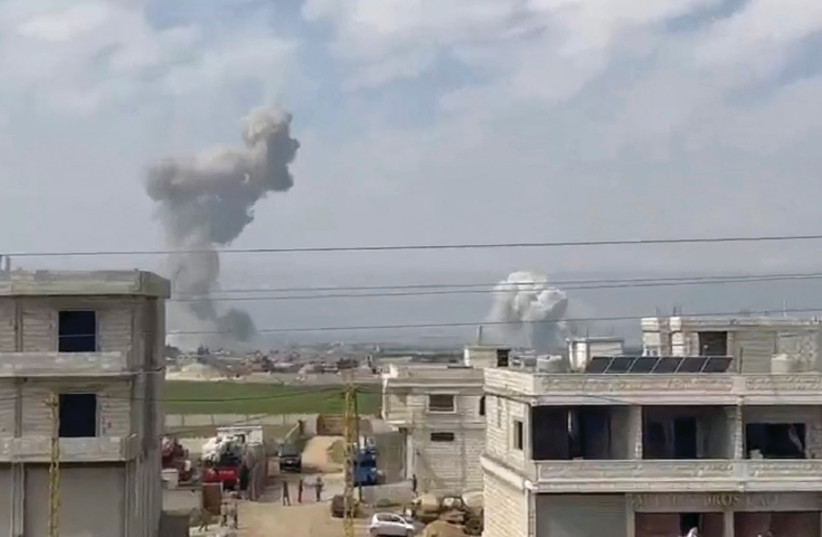Hezbollah escalated attacks on Israel this week, targeting Mount Meron on Tuesday and Kiryat Shmona on Wednesday, killing one man and wounding another. Hezbollah’s dangerous escalation showcases the Iranian-backed terrorist group’s attempt to keep Israelis from returning to the North and its attempt to carve out a control zone inside sovereign Israel.
Some commentators have compared this to a “security zone,” the area Israel used to control in southern Lebanon; Hezbollah now “controls” this area because it succeeded in enacting evacuations and continuously rains down rockets.
Each of Hezbollah’s attacks is more calculated than the last.
The group claimed that there was an attack on Jama’a Islamiyah, a group “closely linked to the Gaza-based Palestinian resistance movement Hamas,” according to Iran’s Fars News. The group said that a number of its members were killed on Tuesday and that an overnight strike “targeted the Islamic Group’s emergency and relief center in Habbariyeh,” Iran’s government PressTV reported.
The IDF said that “overnight, fighter jets struck a military compound in the area of al-Habbariyeh in Southern Lebanon. In the compound, a significant terrorist operative belonging to the Jama’a Islamiyah organization who advanced attacks against Israeli territory was eliminated along with additional terrorists who were with him.” Oddly, when speaking to Iranian media, Jama’a Islamiyah requested anonymity.

According to the Iranian report, they “said [that] a dozen medical staff were in the emergency center at the time of the strike, adding that bodies were being pulled from the rubble.” A Lebanese politician has since slammed the “Israeli aggression.”
Hezbollah claimed it retaliated for this attack by targeting an Israeli “brigade” office in Kiryat Shmona, an attack Iranian media picked up on. The area it claimed it attacked was the “Hiram” brigade, which is supposed to secure the eastern section of the Israel-Lebanon border under the 91st IDF Division.
On Wednesday, Hezbollah targeted the IDF base on Mount Meron. It has, in the past, claimed to attack other IDF posts and bases, including the Northern Command in Safed. What makes this incident different than in the past is that Hezbollah claimed to retaliate after a Hamas-affiliated group was targeted in Lebanon.
Throughout the past six months, Hezbollah has chosen to continue to “manage” the conflict with Israel, seeking to attack along the North with impunity. However, it troubles to explain each attack and shows that it can always escalate further, but is holding back from a full-scale war.
Israel's security strategy amid regional threats
It also sends messages indicating that if the war in Gaza ends, Hezbollah will halt its attacks. Israel’s messaging has been quite the opposite, asserting that the Hezbollah threat needs to be visibly diminished – i.e. leave the border – otherwise, the Israeli threat will not diminish. Israel, for its part, is choosing its own way to manage this conflict, preferring for now to focus on Gaza.
With Defense Minister Yoav Gallant discussed the broader security situation this week in Washington with American officials, IDF Chief Spokesman R.-Adm. Daniel Hagari praised Israel-US cooperation: “In all my years, I cannot recall such extensive cooperation as we currently have with the US Central Command, encompassing the entire US military and the US intelligence services.
“Such collaboration has not existed previously,” he continued. “We are experiencing unprecedented levels of intelligence coordination.” This is a slightly different kind of messaging that shows Israel and the US are working closely together. Nevertheless, the images out of the North of Hezbollah’s attack on Wednesday continue to show how its rockets bring death and destruction. Hezbollah announced more losses on Wednesday, publishing images of two Hezbollah members who had been killed.
Iran’s Public Relations Office of the IRGC in Alborz province said on Tuesday that one of its members was killed in Syria, blaming Israel for the “raid” in Deir Ezzor. Iran said that Behrouz Vahedi of the IRGC Quds Force in Syria was killed. It claimed that he had gone to Syria to fight ISIS.
Iran continues to threaten Israel via its proxies in Iraq and Syria and also to move weapons to Hezbollah in Lebanon. Gallant said in Washington that Israel is facing a seven-front conflict and that Iran is behind threats on those fronts.
